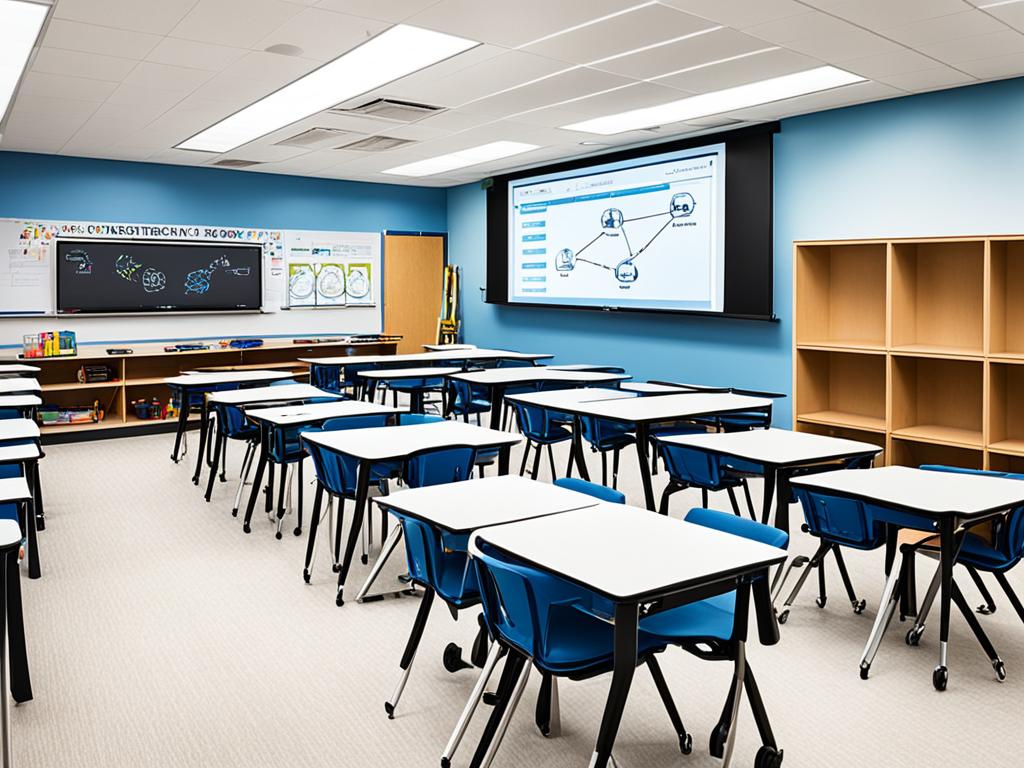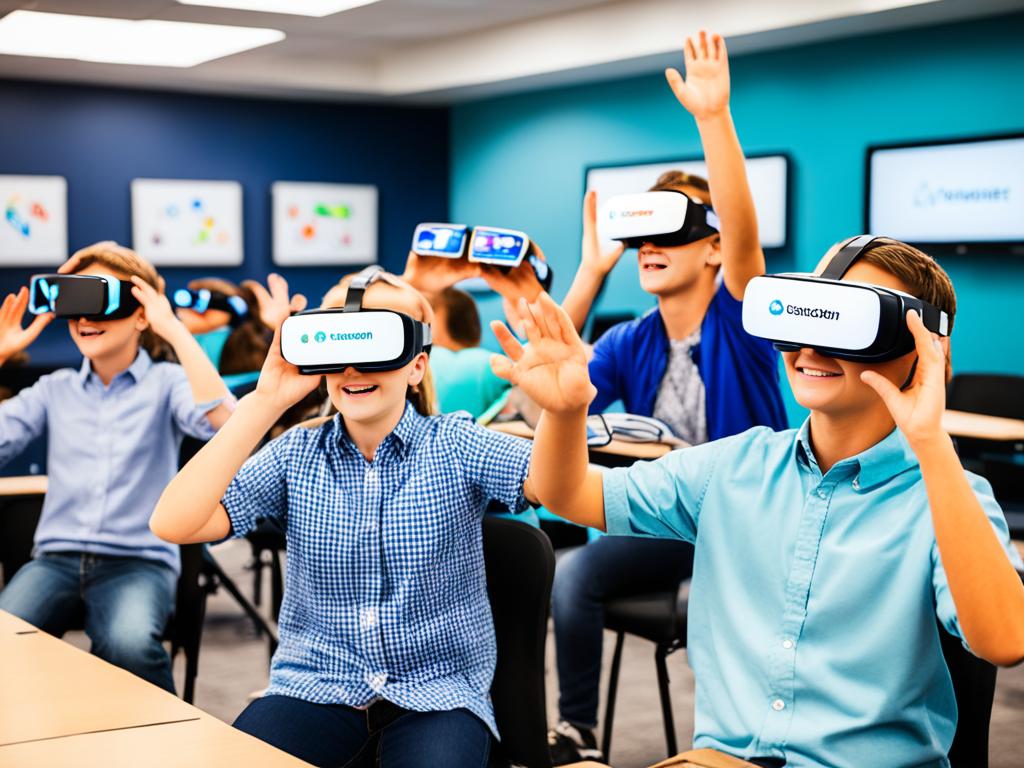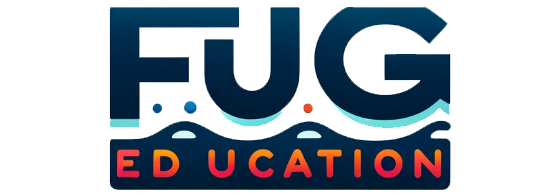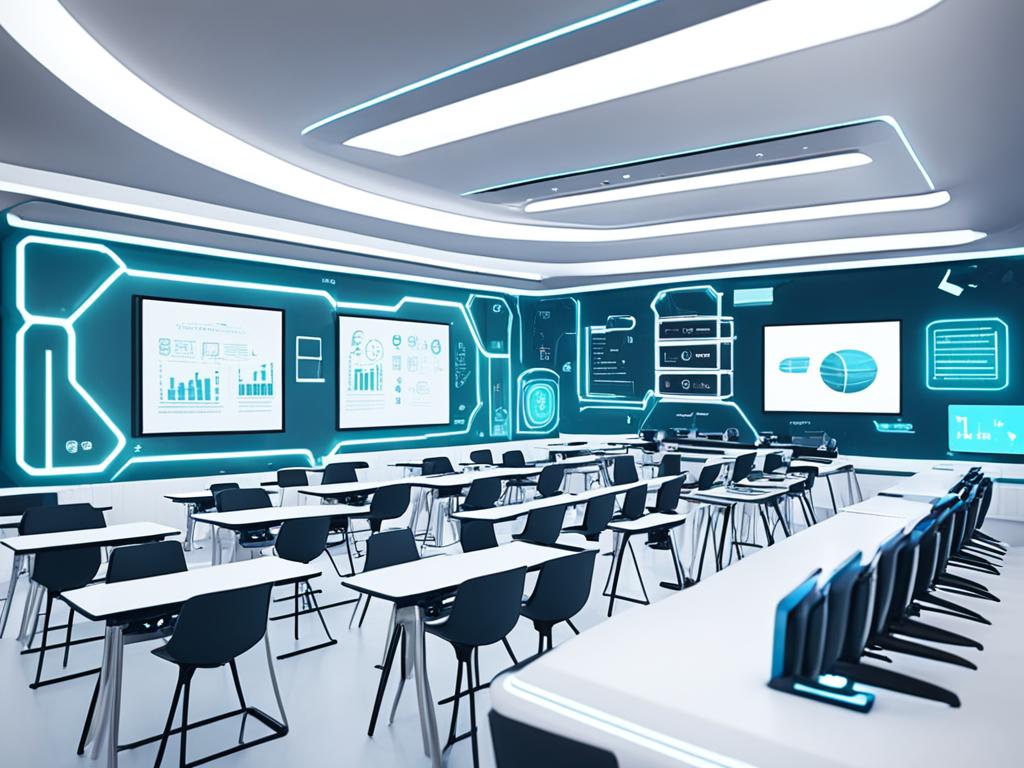In this digital age, education is experiencing a revolution. Technological advancements have opened up a world of possibilities in the field of teaching, transforming the way educators engage with students and deliver lessons. From innovations in education technology to cutting-edge tools and transformative solutions, technology is empowering educators to create personalized and dynamic learning experiences for their students.
In this article, we will explore the latest education technology innovations that are reshaping the landscape of teaching. We will delve into emerging edtech trends, disruptive technologies, and advancements in educational technology. We will also take a closer look at the impact of these innovations on teaching methods and student outcomes.
Join me as we uncover the world of transformative edtech tools and innovative learning technologies. Discover the potentials of technology in education and how it is revolutionizing the teaching experience.
Key Takeaways:
- Innovations in education technology are revolutionizing the teaching landscape.
- Advancements in educational technology offer personalized and dynamic learning experiences.
- Emerging edtech trends and transformative tools are shaping the future of education.
- Cutting-edge technologies have the potential to improve teaching methods and student outcomes.
- Technology in education empowers educators to create engaging and interactive learning environments.
The Role of Educational Technological Advancements in Modern Curriculums
In this section, we will examine the crucial role of educational technological advancements in shaping modern curriculums. From interactive digital textbooks to virtual reality simulations, educational technology is revolutionizing the way curriculum is designed and delivered.
These advancements in educational technology are enhancing student engagement, promoting active learning, and preparing students for a technologically advanced future. With transformative edtech tools and digital innovations in the classroom, educators have a wealth of resources and opportunities to create more interactive and personalized learning experiences.
Through the integration of digital tools, students can now explore complex concepts in a more immersive and hands-on manner. For example, virtual reality simulations can transport students to historical events or scientific phenomena, allowing them to actively participate and deeply understand the subject matter.
Moreover, educational technological advancements enable educators to personalize instruction to meet the unique needs and interests of each student. Adaptive learning platforms and intelligent tutoring systems can assess students’ strengths and weaknesses and provide targeted feedback and support, fostering a more personalized and effective learning environment.
Advances in educational technology also assist in bridging the gap between the classroom and the real world. Students can collaborate with peers from around the globe, engage in authentic research projects, and develop the critical thinking and problem-solving skills necessary for success in the digital age.
As curriculum developers continually incorporate digital innovations in the classroom, educators can unleash the full potential of technology to enhance teaching and learning. By embracing these technological advancements, educators can create dynamic and engaging learning experiences that prepare students for the challenges and opportunities of the 21st century.
Innovative Learning Technologies within Dulwich College International Schools
In this section, we will take a closer look at the innovative learning technologies implemented within Dulwich College International schools. These schools have been at the forefront of integrating technology into their curriculum, leading to top International Baccalaureate (IB) scores.
Technological Integration in Curriculum: Leading to Top IB Scores
At Dulwich College International, technology is seamlessly integrated into the curriculum, enhancing teaching and learning across various subjects. By incorporating cutting-edge education technology into the curriculum, students gain access to interactive resources, digital tools, and virtual learning environments. This integration has proven to be highly effective, as evidenced by the exceptional IB scores achieved by Dulwich College International schools. The use of technology not only engages students but also enables them to develop essential digital skills and thrive in a rapidly evolving world.
Dulwich College International: A Glimpse into Tech-enhanced Learning Environments
Dulwich College International schools provide tech-enhanced learning environments that promote active student engagement and collaboration. Students have access to state-of-the-art facilities equipped with advanced technological resources, including interactive whiteboards, multimedia projectors, and digital learning platforms. These technology-rich environments enable students to explore and apply their knowledge in innovative ways, enhancing their critical thinking and problem-solving skills. As a result, students develop a deep understanding of the subjects they study and cultivate a passion for lifelong learning.
Inspirational Achievements: Shortlisted Nominations for Education Awards
The commitment to leveraging innovative learning technologies at Dulwich College International has resulted in inspirational achievements that have been recognized by the education community. Several Dulwich College International schools have received shortlisted nominations for prestigious education awards, highlighting their dedication to delivering excellence in teaching and learning through technology integration. These nominations serve as a testament to the positive impact of innovative learning technologies and the exceptional work carried out by educators and students within the Dulwich College International network.
| School | Award |
|---|---|
| Dulwich College Beijing | Best Use of Technology in Education Award |
| Dulwich College Singapore | Innovation in Education Award |
| Dulwich College Seoul | Excellence in Technology Integration Award |
These achievements not only recognize the accomplishments of the schools but also inspire other educational institutions to explore and embrace the power of innovative learning technologies for the betterment of teaching and learning.
Join us as we continue to explore the transformative impact of education technology in the upcoming sections.
Advancements in Education Technology: A Global Perspective
In this section, we will broaden our perspective and explore the advancements in education technology on a global scale. From Europe to Asia, North America to Africa, educational technology is transforming the way students learn and teachers teach. We will delve into the latest trends and innovations in education technology from around the world, highlighting the diverse approaches and solutions being implemented in different educational settings. Join us as we embark on a journey to discover the global landscape of education technology and its impact on teaching and learning.
Transformative Edtech Tools: Shaping the Future of Education
In today’s evolving educational landscape, transformative edtech tools are playing a crucial role in shaping the future of education. These innovative technologies are revolutionizing the learning experience, enabling educators to create dynamic and engaging lessons that prepare students for a technologically advanced future.
One of the key examples of transformative edtech tools is the integration of STEAM (Science, Technology, Engineering, Art, Mathematics) and entrepreneurship within the SE21 facility at Dulwich College Shanghai Pudong. This cutting-edge facility provides students with hands-on experiences in diverse disciplines, fostering creativity, critical thinking, and problem-solving skills. By combining STEAM and entrepreneurship, students are equipped with a holistic skill set that prepares them for the challenges and opportunities of the 21st-century workforce.
At Dulwich College Shanghai Pudong’s SE21 facility, the power of a multi-disciplinary approach is harnessed to deliver tech-infused learning experiences. By integrating different subject areas and leveraging technology, students gain a deeper understanding of real-world applications and develop the ability to think across disciplines. This approach encourages collaboration, cultivates innovation, and empowers students to become agile learners in an increasingly interconnected world.
Ultimately, the use of transformative edtech tools in education holds great promise. It empowers both educators and students to embrace the possibilities of technology and prepares them for a rapidly evolving future. By encouraging a multi-disciplinary approach and infusing technology into learning, we can shape a generation of learners who are adaptable, creative, and ready to thrive in a world driven by technology.
| Benefits of Transformative Edtech Tools | SE21 Facility at Dulwich College Shanghai Pudong |
|---|---|
|
|
Challenges and Opportunities in Digital Innovations in the Classroom
In the ever-evolving landscape of education, digital innovations have become an integral part of the classroom. These advancements bring forth a myriad of challenges and opportunities for educators as they navigate the integration of technology into teaching practices. From infrastructure limitations to student engagement, there are various factors that require careful consideration.
One of the key challenges faced by educators is the need for reliable and accessible technology infrastructure. Limited access to devices, inadequate internet bandwidth, and outdated hardware can hinder the effective implementation of digital innovations. Addressing these infrastructure limitations is crucial to ensure equal access to technology and create a level playing field for all students.
Another challenge lies in effectively engaging students in the digital learning environment. As technology continues to evolve, educators must continually adapt their teaching methods to keep pace with changing student expectations and preferences. Creating interactive and immersive digital experiences that captivate students can enhance their learning outcomes and foster a deeper understanding of the subject matter.
Insights from the World Economic Forum: “Topp Jirayut” on Digital Assets
“Topp Jirayut,” an esteemed speaker at the World Economic Forum, shared valuable insights on the role of digital assets in education. Digital assets, such as online learning platforms, digital textbooks, and educational apps, have the potential to revolutionize the classroom experience. They provide students with access to a vast array of resources and learning opportunities, enabling personalized and self-paced learning.”
By leveraging digital assets, educators can tailor their teaching to meet the unique needs of each student, fostering a more inclusive and engaging learning environment. However, with the proliferation of digital assets, building trust becomes paramount. Ensuring the reliability, accuracy, and security of digital resources is crucial to provide students and educators with a safe and authentic learning experience.
Building Trust and Establishing Credible Digital Asset Regulations in Education
To address these challenges and maximize the opportunities brought forth by digital innovations, it is essential to establish credible regulations for digital assets in education. Governments, educational institutions, and industry stakeholders need to work collaboratively to develop frameworks that ensure the quality, accessibility, and ethical use of digital resources.
Regulations should focus on aligning educational objectives with digital asset usage, safeguarding student privacy and data security, and promoting responsible digital citizenship among students. By setting clear guidelines and standards, trust can be fostered among all stakeholders, creating a solid foundation for the integration of digital innovations in the classroom.
As the field of education continues to embrace digital innovations, it is imperative that educators and policymakers strive to overcome challenges and seize the opportunities presented by technology. By addressing infrastructure limitations, enhancing student engagement, and establishing credible regulations, we can unlock the full potential of digital innovations in the classroom and pave the way for a transformative education experience.
Leveraging Cutting-edge Education Technology in Comparative Medicine Research
In this section, we will explore the use of cutting-edge education technology in comparative medicine research. Educational institutions are leveraging technology to advance research in the field of medicine and enhance the understanding of human health and disease.

We will highlight specific examples and case studies where education technology has played a transformative role in comparative medicine research. By utilizing state-of-the-art tools and methodologies, researchers are able to gather and analyze vast amounts of data, accelerating the pace of discovery and innovation.
Through the application of virtual reality simulations, artificial intelligence algorithms, and advanced imaging techniques, scientists can gain deeper insights into complex biological systems and diseases. This technology enables them to visualize, model, and manipulate data in ways that were previously unimaginable.
Furthermore, education technology has fostered interdisciplinary collaboration among researchers, bringing together experts from various fields such as medicine, genetics, computer science, and data analytics. This interdisciplinary approach paves the way for groundbreaking discoveries and breakthroughs in comparative medicine research.
By leveraging cutting-edge education technology, researchers are transforming the landscape of medicine, offering new avenues for diagnosis, treatment, and prevention of diseases. The integration of technology into comparative medicine research has the potential to revolutionize healthcare practices, improve patient outcomes, and ultimately save lives.
Disruptive Technology in Education: Beyond the Traditional Learning Paradigms
In today’s rapidly evolving digital landscape, disruptive technology in education is paving the way for a new era of learning. Traditional learning paradigms are being challenged and transformed as technology takes center stage in classrooms worldwide. From virtual classrooms to personalized learning platforms, technology is reshaping the way education is delivered and experienced.
Exploring the Intersection of Technology, Wellbeing, and Holistic Education
One of the key aspects of disruptive technology in education is its ability to bridge the gap between technology and wellbeing. Technology not only enhances the learning experience but also supports students’ mental health, social-emotional wellbeing, and overall holistic development. By integrating technology into education, educators can create a more inclusive and supportive learning environment that prioritizes the wellbeing of students.
For example, digital tools can provide students with personalized learning experiences tailored to their individual needs and preferences. This personalized approach helps students engage more deeply with the content, leading to improved learning outcomes and greater overall satisfaction.
Furthermore, technology can facilitate holistic education by offering a diverse range of resources and learning opportunities. Students can explore different subjects, cultures, and perspectives through global connectivity, fostering a broader understanding of the world. This interconnectedness promotes empathy, critical thinking, and cultural awareness.
The Influence of Edtech on Personalised Learning and Global Connectivity
Edtech, or educational technology, plays a pivotal role in enabling personalized learning and global connectivity. With the help of edtech tools, educators can create customized learning pathways for students based on their individual strengths, interests, and learning styles.
Through personalized learning platforms, students can work at their own pace, receive immediate feedback, and access a wealth of resources that cater to their specific needs. This tailored approach not only increases student engagement but also empowers students to take ownership of their learning journey.
In addition to personalized learning, edtech promotes global connectivity by breaking down geographical boundaries. Students can connect with peers and experts from around the world, collaborating on projects, sharing perspectives, and gaining valuable insights. This global connectivity enhances cultural awareness, encourages collaboration, and prepares students for a future that is increasingly interconnected.
Disruptive technology in education holds immense potential to transform the traditional learning paradigms, empowering both educators and students in the process. By embracing edtech, we can create a future where technology seamlessly integrates with holistic education, personalized learning, and global connectivity.
| Benefits | Impact |
|---|---|
| Personalized Learning | Improved student engagement and learning outcomes |
| Wellbeing and Holistic Development | Support for mental health and social-emotional wellbeing |
| Global Connectivity | Cultural awareness, collaboration, and preparation for a globalized future |
Emerging Edtech Trends: Preparing Students for a Technologically Advanced Future
In today’s rapidly evolving world, it is vital for students to develop the skills and competencies necessary to thrive in a technologically advanced future. Emerging edtech trends are paving the way for innovative and engaging learning experiences that equip students with the tools they need to succeed in the digital age. From artificial intelligence and machine learning to robotics and coding, these trends are reshaping education and preparing students to navigate a world that is increasingly driven by technology.
Let’s take a closer look at some of the key edtech trends that are transforming classrooms and preparing students for the challenges and opportunities of the future.
- Artificial Intelligence and Machine Learning: AI and machine learning technology are revolutionizing education by personalizing learning experiences, providing adaptive feedback, and identifying areas where students may need additional support. Intelligent tutoring systems and AI-powered chatbots are just some of the tools being used to enhance learning outcomes and promote student success.
- Robotics: The integration of robotics in the classroom not only engages students in hands-on learning but also fosters critical thinking, problem-solving, and collaboration skills. From simple coding robots to advanced humanoid robots, students are gaining valuable insights into the field of robotics while developing essential 21st-century skills.
- Coding: As digital literacy becomes increasingly important, coding skills are becoming a staple in education. Coding platforms, such as Scratch, enable students to learn programming languages in a fun and interactive way. These skills are not only valuable for potential careers in technology but also enhance logical thinking and creativity.
These emerging edtech trends are already making a significant impact on classrooms around the world. By introducing students to these technologies, educators are equipping them with the necessary skills and knowledge to excel in a technologically advanced future.

Through hands-on experiences and interactive learning opportunities, students are developing a deep understanding of these technologies and their potential applications in various industries. By staying ahead of emerging edtech trends, educators are ensuring that students are not only prepared for the future but also inspired to become innovators and leaders in their own right.
Conclusion
In conclusion, the impact of edtech innovations on educational outcomes has been remarkable. The integration of technology in teaching methods has transformed traditional classrooms into dynamic learning environments, enhancing student engagement and promoting active learning. Students are now able to use digital tools and resources to explore concepts, collaborate with their peers, and develop critical thinking and problem-solving skills.
Furthermore, edtech has also contributed to improved learning outcomes. Through personalized learning platforms, adaptive assessments, and data analytics, educators can tailor their instruction to meet the individual needs of students. This leads to better academic performance, increased motivation, and a deeper understanding of the subject matter.
Looking ahead, the future of education lies in sustainable technological integration. As edtech continues to evolve, we envision a learning landscape where technology seamlessly integrates with pedagogy, providing educators with powerful tools to enhance their teaching practices and foster student success. This integration should be mindful of accessibility, inclusivity, and equity, ensuring that all students can benefit from the advantages offered by education technology.
In conclusion, edtech has revolutionized the way we teach and learn, and it holds tremendous potential for the future of education. By reflecting on the impact of edtech innovations on educational outcomes and envisioning a future with sustainable technological integration, we can empower educators, engage students, and create a truly transformative learning experience.
FAQ
What are some examples of innovations in education technology?
Examples of innovations in education technology include interactive digital textbooks, virtual reality simulations, artificial intelligence, augmented reality, robotics, and coding platforms.
How are educational technological advancements shaping modern curriculums?
Educational technological advancements are reshaping modern curriculums by introducing interactive digital tools, personalized learning platforms, and immersive learning experiences such as virtual reality simulations.
How are innovative learning technologies integrated into Dulwich College International schools?
Dulwich College International schools seamlessly integrate innovative learning technologies into their curriculum, incorporating tools such as interactive whiteboards, tablets, and online educational platforms for enhancing teaching and learning across various subjects.
What are some emerging edtech trends that are preparing students for a technologically advanced future?
Emerging edtech trends include artificial intelligence, machine learning, robotics, coding, and digital literacy initiatives that aim to equip students with the skills and competencies required in the digital age.
What are the challenges and opportunities in implementing digital innovations in the classroom?
Challenges in implementing digital innovations in the classroom include infrastructure limitations, ensuring student engagement, and maintaining a balance between traditional teaching methods and technology integration. Opportunities include personalized learning, enhanced student engagement, and access to educational resources.
How is cutting-edge education technology revolutionizing comparative medicine research?
Cutting-edge education technology is revolutionizing comparative medicine research by enabling researchers to use virtual dissection tools, medical simulations, and advanced imaging techniques to enhance their understanding of human health and disease.
How is disruptive technology changing the traditional learning paradigms in education?
Disruptive technology in education, such as virtual classrooms and personalized learning platforms, is challenging traditional learning paradigms by offering flexible learning opportunities, personalized instruction, and access to global educational resources.
What are some of the emerging edtech trends that are shaping the future of education?
Emerging edtech trends shaping the future of education include artificial intelligence, machine learning, adaptive learning technologies, gamification, and virtual and augmented reality tools.
What is the impact of edtech innovations on educational outcomes?
Edtech innovations have had a positive impact on educational outcomes by improving student engagement, promoting active learning, and facilitating personalized instruction. They have also provided teachers with powerful tools for assessing student progress and identifying areas for improvement.
Source Links
- https://www.kxan.com/business/press-releases/cision/20240128CN20855/topp-jirayut-pinpoints-3-challenges-on-digital-assets-at-world-economic-forum-2024
- https://www.biospace.com/job/2862683/lab-assistant-r-and-d-comparative-medicine/
- https://www.thatsmags.com/shanghai/post/37050/which-school-group-topped-the-ib-results-table_3

